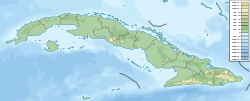
Back Havana ACE Havana Afrikaans Havanna ALS ሀቫና Amharic L'Habana AN Hafana ANG هافانا Arabic هابانا ARY هاڤانا ARZ L'Habana AST
Havana
La Habana | |
|---|---|
|
| |
| Nickname: City of Columns[1] | |
| Coordinates: 23°08′12″N 82°21′32″W / 23.13667°N 82.35889°W | |
| Country | |
| Established | 16 November 1519 (current place) |
| Municipalities | 15 |
| Government | |
| • Body | Gobierno Provincial de La Habana |
| • Governor | Reinaldo García Zapata (PCC) |
| Area | |
| 728.26 km2 (281.18 sq mi) | |
| Elevation | 59 m (195 ft) |
| Population (2021) | |
| 2,142,939[2] | |
| • Rank | 7th in North America 1st in Cuba |
| • Density | 2,942.5/km2 (7,621/sq mi) |
| • Urban | 100 % |
| Demonym | Habaneros-habaneras |
| GDP (PPP, constant 2015 values) | |
| • Year | 2023 |
| • Total | $41.1 billion[3] |
| • Per capita | $19,100 |
| Time zone | UTC−5 (UTC−05:00) |
| • Summer (DST) | UTC−4 (UTC−04:00) |
| Patron saint | San Cristóbal |
| HDI (2019) | 0.834[4] – very high |
| Website | www |
| Official name | Old Havana and its Fortification System |
| Type | Cultural |
| Criteria | iv, v |
| Designated | 1982 (6th session) |
| Reference no. | 204 |
| Region | the Caribbean |
Havana (/həˈvænə/; Spanish: La Habana [la aˈβana] ⓘ)[5] is the capital and largest city of Cuba. The heart of La Habana Province, Havana is the country's main port and commercial center.[6] It is the most populous city, the largest by area, and the second largest metropolitan area in the Caribbean region. The population in 2012 was 2,106,146 inhabitants,[7][6] and its area is 728.26 km2 (281.18 sq mi)[2] for the capital city side and 8,475.57 km2 for the metropolitan zone.[7] Its official population was 1,814,207 inhabitants in 2023.
Havana was founded by the Spanish in the 16th century. It served as a springboard for the Spanish conquest of the Americas, becoming a stopping point for Spanish galleons returning to Spain. King Philip III of Spain granted Havana the title of capital in 1607.[8] Walls and forts were built to protect the city.[9] The city is the seat of the Cuban government and various ministries, and headquarters of businesses and over 100 diplomatic offices.[10] The governor is Reinaldo García Zapata of the Communist Party of Cuba (PCC).[11][12] In 2009, the city/province had the third-highest income in the country.[13]
Contemporary Havana can essentially be described as three cities in one: Old Havana, Vedado and the newer suburban districts.[14] The city extends mostly westward and southward from the bay, which is entered through a narrow inlet and which divides into three main harbors: Marimelena, Guanabacoa and Antares. The Almendares River traverses the city from south to north, entering the Straits of Florida a few miles west of the bay.[15]
The city attracts over a million tourists annually;[16] (1,176,627 international tourists in 2010,[16] a 20% increase from 2005). Old Havana was declared a UNESCO World Heritage Site in 1982.[17] The city is also noted for its history, culture, architecture and monuments.[18] As typical of Cuba, Havana experiences a tropical climate.[19]
- ^ "How Obama's US-Cuba deal could shape Havana's future". Lonely Planet. Archived from the original on 10 January 2015. Retrieved 10 January 2015.
- ^ a b "Demographic Yearbook of Cuba 2021/Anuario Demografico de Cuba 2021 (in Spanish)" (PDF). Archived from the original (PDF) on 18 November 2022. Retrieved 4 August 2022.
- ^ "TelluBase—Cuba Fact Sheet" (PDF). Tellusant. Retrieved 2024-01-11.
- ^ "Subnational Human Development Index". Global Data Lab. Retrieved 16 June 2020.
- ^ Cabrera, Lydia (2019-04-01). Anagó: vocabulario lucumí: El yoruba que se habla en Cuba (in Spanish). Linkgua. ISBN 978-84-9007-834-1.
- ^ a b Cuba. The World Factbook. Central Intelligence Agency.
- ^ a b "Población total por color de la piel según provincias y municipios" (PDF). 2012 Official Census. Oficina Nacional de Estadística e Información. Archived from the original (PDF) on 10 November 2013.
- ^ "Havana". The Free Dictionary.
capital of Spanish Cuba in 1552
- ^ "Old Havana". www.galenfrysinger.com.
- ^ "Cuba – Embassies and Consulates". Embassypages.com. Archived from the original on 4 October 2018.
- ^ San Miguel, Raúl (18 January 2020). "Electos el Gobernador y Vicegobernadora en La Habana". Tribuna de La Habana (in Spanish).
- ^ (in Spanish) [1] Archived 22 January 2020 at the Wayback Machine Preside Esteban Lazo toma de posesión de las autoridades de Gobierno en La Habana
- ^ "Workforce and Salary (Section 4.5)" (in Spanish and English). Oficina Nacional de Estadisticas – Republica de Cuba. Archived from the original on 2010-12-16.
- ^ Cite error: The named reference
:2was invoked but never defined (see the help page). - ^ "Anuario Estadistico de Ciudad de La Habana" (in Spanish). ONE – Oficina Nacional de Estadisticas (National Statistics Office). Archived from the original on 4 August 2011. Retrieved 28 November 2011.
- ^ a b "Section 15 (Turismo), article 15.7 (Visitantes por mes)" (in Spanish). ONE- Oficina de Estadisticas de Cuba. Archived from the original on 4 August 2011. Retrieved 28 November 2011.
- ^ "Old Havana and its Fortification System". UNESCO World Heritage Centre. UNESCO.ORG.
- ^ Goodsell, James Nelson (11 April 2017). "Havana". Encyclopædia Britannica.
- ^ "Havana climate summary". Weatherbase. Archived from the original on 20 December 2016. Retrieved 23 March 2016.
© MMXXIII Rich X Search. We shall prevail. All rights reserved. Rich X Search










